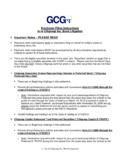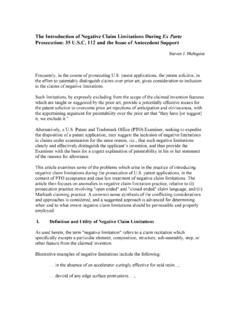Transcription of The Case against Heathrow Expansion - HACAN
1 The Case against Heathrow Expansion This short paper sets out the case against Heathrow Expansion . We argue there are strong social, environmental, educational, health and equity reasons to oppose Expansion . Here are probably safety reasons too. And the economic case for Expansion is looking shakier the more it is examined. We deal with each point in turn. We also point to a positive way forward. reasons to oppose Expansion Social Noise The Department for Transport claims that, despite a 50% increase in aircraft numbers, noise levels will fall, or at worst, not increase! They can only make this startling claim by playing around with the noise figures. The Department only accepts that most people are bothered by aircraft noise in areas where noise levels average out at 57 decibels or more over the course of a year. This effectively means just the boroughs of Hounslow and Richmond in London and, on the other side of Heathrow , parts of Berkshire and Surrey.
2 This doesn t tie in with people s experience. Nor does it tally with the World Health Organisation (WHO) figures. The WHO found that people start to get moderately annoyed when noise averages out 50 decibels and severely annoyed when it averages out at 55 decibels. The difference in the numbers affected is huge. About 230,000 people are affected at 57 decibels, live within the 57 decibel contour. 1-2 million people live within the 50 decibel contour. What is even more astonishing than the Government s rejection of the WHO findings is its dismissal of its own study, the ANASE Study, which came up with very similar findings to the WHO. ANASE was a major study. It cost over 1 million, took six years to complete and was the first major study into attitudes towards aircraft noise for twenty years.
3 It didn t mark out a level at which a significant number of people start to get annoyed by aircraft noise but found it was well below 57 decibels and suggested it was around 50 decibels or even lower. It also criticised the method of averaging out noise, arguing that it didn t take full account of the effect of the huge number of planes now using Heathrow . The Government accepted these two findings of the study but decided not to adopt them into policy because it felt there were flaws in other (non-related) parts of the study. All this means that the whole basis of the Government s claims that noise levels will not worsen if Expansion takes place is flawed, and even fraudulent. Community Destruction In the consultation document the Department for Transport accepts that around 700 homes (including the entire village of Sipson) will need to be demolished to make way for a 3rd runway and a 6th terminal.
4 What it doesn t spell out is that this is the barest minimum. This figure does not include the properties which would need to be taken for new or widened roads or those which would be so close to the airport that they would become uninhabitable. Schools, churches, homes, would need to be demolished. Some estimate that up to 10,000 people would need to be removed. That would make it one of the biggest forced removal of people in the last 100 years. Environmental Climate Change In the UK aviation is the fastest-growing contributor to climate change. It already accounts for 6% of climate change emissions. According to an answer given to a Parliamentary Question by Gillian Merron MP when she was Aviation Minister last year, this rises to 13% if radiative forcing is taken into account. (Radiative forcing is not universally accepted it the term use to describe that, because a lot of emissions from planes are emitted at a very high altitude, they are particularly damaging to the climate).
5 According to the World Development Movement a third runway alone would emit as much CO2 (the climate change gas) in one year as the whole of Kenya. The Government and the aviation industry argue that the inclusion of aviation in the European Emissions Trading System (ETS) will deal with the problem. (This is the system where airlines by permits to pollute). But the ETS will only cut European growth in emissions from 142% to somewhere between 135 139% by 2020. Hardly the panacea for climate change! Air Pollution The Department for Transport claims that the proposed Expansion of the airport from 473,000 flights in 2006 to over 700,000 by 2020 will still allow the airport pollution limits to stay within the EU limits. Many independent observers doubt this. Several areas around Heathrow already exceed the EU limits (due to come into force in 2010).
6 The Department argues that the arrival of cleaner planes will enable the airport to stay within the limits despite the huge projected growth in the number of planes. But this is generally regarded as over-optimistic. A good analysis of this can be found in the report by the Aviation Environment Federation, Emissions:Impossible - Educational There is considerable anecdotal and research evidence to show that children s education can suffer when they attend schools under the flight path. For some children a plane passes overhead every 90 seconds for part of the day. The Expansion proposals will only make things worse. There will be schools under a flight path for the first time (the flight path to a 3rd runway). And the half day of peace and quiet which many of the schools under the existing flight paths currently enjoy will disappear if runway alternation is abolished.
7 The best studies on how children s education can suffer are by Professor Stephen Stansfield of Queen Mary s College. They include the comprehensive RANCH Study. Health There is considerable evidence that people s health is affected by aircraft noise. Recent research the HYENA Study from Imperial College in London, carried out by Dr Lars Jarrup and his team, found that people can get stressed out (and therefore by more prone to high-blood pressure and heart failure) when they are subjected loud noises at night (such as night flights) or to constant noise during the day (such as a plane coming over every 90 seconds). The study is backed up by a lot of research from across Europe. Much of that research is brought together in Guidelines for Community noise, by Berglund et al, published in 2000 for the World Health Organisation.
8 Equity A lot of accusations are made that, if we oppose Expansion , we are denying poorer people the right to fly. But it is much more complex than that. The majority of flights even on the budget airlines (which don t use Heathrow ) are taken by better-off people. Indeed, the real growth in recent years has been amongst the wealthiest 10% of the population taking many more weekend breaks abroad. And that is the trend which is expected to continue. The poorest 10% of the population hardly ever fly (because of the overall cost of the holiday). This means that the significant tax-breaks the aviation industry enjoys ( 9 billion through tax-free fuel and exemption from VAT and anywhere between 4 billion and 24 billion to cover the costs of flying s impact on noise, climate change, air pollution and biodiversity) are deeply regressive.
9 And the deeper equity issue is the impact of climate change will have on the people of the planet if it kicks in hard, it will affect the poorest in poor countries first and most acutely. The Question of Safety Although Heathrow has a good safety record, what is significant is that neither the Civil Aviation Authority not National Air Traffic Control has given the green light for the current Expansion proposals. They would need to do so before these proposals went ahead. The Shaky Economic Case for Expansion The Department for Transport justifies the Expansion of Heathrow on economic grounds. Its evidence is shaky. There is no doubt that Heathrow has benefited the economy of West London, London as a whole and, indeed, the UK. But that is not what is in dispute. The Department for Transport and the aviation industry claim that Expansion is essential for continued economic prosperity.
10 Is that true? HACAN commissioned the independent Dutch consultancy CE Delft (who have done work for national governments, the European Commission, the aviation industry and NGOs) to assess the claims. Below are the main points they found. 1. CE Delft s report casts doubt upon the Government s estimate that Expansion at Heathrow will bring economic benefits of 5 billion (over 70 years). It argues this figure is too high for two main reasons : a. The suppressed business demand that would be released by Expansion at Heathrow is significantly over-estimated by the Oxford Economic Forecasting (OEF) reports of 1999 and 2006, on which the Heathrow calculations are based. The DfT s own estimates are that mixed-mode , for example, will attract million extra business passengers by 2015 whereas OEF assumed six times as many 3 million.





